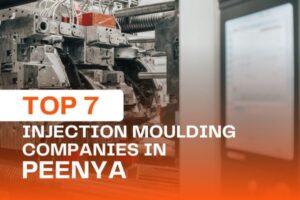Injection Mold (Explained with Components)
Injection molding is a widely used manufacturing process for producing plastic parts. The process involves creating a mold that shapes molten plastic into the desired form. Each mold consists of several key components, all of which play a critical role in the performance and efficiency of the molding process.
1. Mold Base
The mold base forms the foundation of the entire mold structure. Manufacturers typically use strong, durable materials like steel or aluminum. Tool steels such as P20 or H13 offer excellent strength and wear resistance, making them ideal for high-pressure molding environments. Aluminum, with its lightweight and superior thermal conductivity, suits less demanding applications.
2. Cavities and Cores
These components shape the plastic part.
-
Core: The core forms the internal features of the molded part, including holes, recesses, and other internal geometries. It must align precisely with the cavity to ensure dimensional accuracy.
-
Cavity: The cavity defines the external surfaces of the part and typically sits on the movable side of the mold. Its design determines surface finish, texture, and contour accuracy.
-
Runner: This channel directs molten plastic from the injection nozzle to the cavity. A well-designed runner maintains a uniform cross-section to promote consistent flow and reduce pressure loss.
-
Gate: The gate, the narrowest part of the runner system, controls how molten plastic enters the cavity. Its size, type, and placement influence flow rate, part strength, and cosmetic appearance.
Mold designers carefully coordinate the design of these components to ensure balanced filling, optimal part quality, and efficient cycle times. Common materials include hardened tool steels like H13, S7, and P20.
3. Sprue Bushing
The sprue bushing channels molten plastic from the nozzle into the runner system. Because it endures high pressure and heat, manufacturers often use hardened tool steels like H13 or corrosion-resistant stainless steel.
4. Locating Ring
This ring ensures proper alignment between the mold and the injection molding machine. Accurate alignment guarantees repeatability and high part quality. Tool steel and high-strength engineering plastics are frequently used for durability.
5. Runner System
The runner system distributes molten plastic evenly to each cavity. Designers often select materials like aluminum alloys or stainless steel to promote smooth flow and resist wear.
6. Ejector Pins
Ejector pins push the molded part out of the cavity after cooling. Hardened tool steels such as H13 or D2 provide the strength and wear resistance required for continuous operation.
7. Ejector Plate
The ejector plate moves the pins forward and backward during the ejection cycle. Mold makers typically use robust materials like P20 or H13 tool steel, or aluminum for lighter-duty applications.
8. Ejector Backing Plate
This plate provides support to the ejector plate, helping it withstand repeated ejection forces. Depending on the mold’s operating conditions, designers choose steel or aluminum for optimal strength and rigidity.
9. Ejector Retainers
These retainers hold the ejector pins in position and allow for easy removal and replacement. Common materials include stainless steel, aluminum alloys, or high-strength plastics like Delrin or nylon.
10. Return Pins and Springs
Return pins reposition the ejector assembly after part removal, while springs maintain the necessary tension. Mold makers usually use hardened steel for pins and high-strength alloys or stainless steel for springs to ensure long-lasting performance.
11. Cooling System
The cooling system uses internal channels to extract heat from the mold and solidify the plastic. To improve thermal conductivity, designers often use copper alloys like beryllium copper, ensuring fast and even cooling.
12. Venting System
Vents allow trapped air and gases to escape during injection. These channels often use hardened steel or stainless steel for strength and resistance to high temperatures and pressures.
13. Guide Pins and Bushings
These components align the mold halves during closing and opening. Manufacturers rely on materials such as hardened tool steels, bronze alloys, or self-lubricating composites to ensure precise movement and minimal wear.
14. Mold Inserts and Lifters
Inserts and lifters help form complex geometries or undercuts. Tool steels like H13 or P20 are common choices due to their strength and ability to withstand repetitive motion and thermal stress. For demanding applications, some designers use beryllium copper or hardened stainless steel.
15. Mold Date and Identification Inserts
These inserts provide markings for production date or identification codes. Depending on durability needs, manufacturers use tool steel, stainless steel, or engineering plastics.
Material Selection Considerations
When selecting materials for each mold component, designers assess expected mold life, complexity, operating conditions, and budget. At Trumould, our team evaluates each project’s needs to choose the right combination of strength, wear resistance, thermal performance, and cost-efficiency.
Conclusion
An injection mold is a complex assembly where every component serves a purpose—from guiding molten plastic to shaping the part and ejecting it efficiently. Careful material selection and component design ensure the mold performs reliably, withstands high pressures and temperatures, and produces consistent, high-quality parts. By leveraging deep industry knowledge, Trumould helps manufacturers build molds that meet their performance and production goals.




